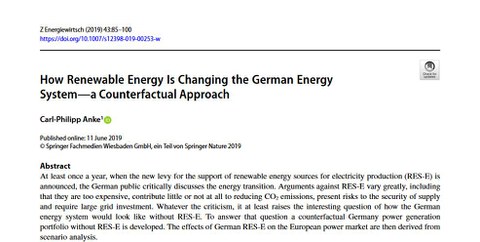03.07.2019
Artikel zu Auswirkungen Erneuerbarer Energien auf den europäischen Strommarkt in der „Zeitschrift für Energiewirtschaft“ erschienen
Das Papier “How Renewable Energy Is Changing the German Energy System — a Counterfactual Approach" von Carl-Philipp Anke (TU Dresden) wurde in der "Zeitschrift für Energiewirtschaft" veröffentlicht und kann unter folgendem Link heruntergeladen werden: https://link.springer.com/article/10.1007/s12398-019-00253-w
Zusammenfassung:
At least once a year, when the new levy for the support of renewable energy sources for electricity production (RES-E) is announced, the German public critically discusses the energy transition. Arguments against RES-E vary greatly, including that they are too expensive, contribute little or not at all to reducing CO2 emissions, present risks to the security of supply and require large grid investment. Whatever the criticism, it at least raises the interesting question of how the German energy system would look like without RES-E. To answer that question a counterfactual Germany power generation portfolio without RES-E is developed. The effects of German RES-E on the European power market are then derived from scenario analysis.
The presented analysis is based on a counterfactual approach using the electricity market model ELTRAMOD, which is based on a cost minimization approach with a time resolution of 8760 h. The modeling problem is split into two models reducing the complexity of the modeled problem: ELTRAMOD-INVEST and ELTRAMOD-DISPATCH. At first, ELTRAMOD-INVEST is used to calculate the counterfactual power plant investments in Germany. Afterwards, the European power plant dispatch is determined with ELTRAMOD-DISPATCH. As RES-E emit no carbon emissions, the carbon price is modeled endogenously to see how German RES-E influence carbon prices and what the effects are.
In the counterfactual scenario, where no German RES-E are installed, the conventional capacity increases up to 8 GW (about 8% of the overall conventional capacity) compared to reality in 2016. That indicates that RES-E prevented investments in conventional capacities. Furthermore power prices in the counterfactual scenario increase up to 18 €/MWh compared to real power prices, which equals the long-term merit order effect. It is composed of three parts: a changed power plant dispatch, higher CO2 prices and additional conventional capacity. The changed power plant dispatch and higher CO2 prices increase the power prices up to 12 €/MWh, in contrast the additional conventional capacity decreases the power price up to 3.5 €/MWh.

